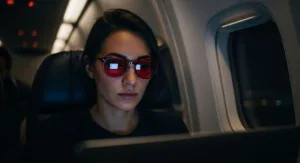Why Biohackers Love Red Lens Jet Lag Glasses to Fix Their Body Clock

If you’ve ever taken a long-haul flight, landed in a new city, and found yourself lying awake at 3 AM or struggling to keep your eyes open at noon, you know how brutal jet lag can be.
It’s not just about feeling tired — it’s about your body’s internal clock, or circadian rhythm, getting completely out of sync. And for shift workers, night nurses, or digital nomads, that same disruption can happen without stepping foot on a plane.
But here’s the good news: there’s a natural, non-pill solution that biohackers and frequent travelers are raving about — red lens jet lag glasses.
Understanding Your Body Clock
Your body clock tells you when to feel awake or sleepy, using light signals from your environment to regulate melatonin — the sleep hormone.
When it’s dark, melatonin production goes up. When it’s light, it drops.
The problem? On planes, in airports, or in brightly lit offices at odd hours, your eyes are bombarded with artificial light — especially blue light from phone screens, tablets, and LED overheads.
Research from Harvard Medical School shows that blue light can suppress melatonin production twice as long as green light wavelengths
Why Red Lens Glasses Can Work
Here’s the science: red lens glasses filter out nearly all blue light while allowing red and orange wavelengths to pass through.

Blue light has short wavelengths (around 450–495 nm) that tell your brain it’s “daytime.” Red and orange light have longer wavelengths (above 600 nm) and don’t disrupt melatonin.
By wearing red lenses after sunset or during a night flight, you’re giving your brain a clear signal: “It’s time to wind down,” even if you’re surrounded by screens and cabin lights.
Real-Life Example: Rachael’s Vancouver Trip
Rachael, a marketing consultant from Toronto, flew to Vancouver for a week of meetings. She used to dread the first two days — groggy mornings, restless nights, and back-to-back coffee runs.
This time, she packed a pair of red lens blue light glasses. On her evening flight, she wore them for the last two hours before “bedtime” in her destination’s time zone. She kept them on while answering emails in her hotel room.

The next morning, Rachael woke up refreshed — no 3 AM wake-ups, no afternoon crash. “It’s like my body clock skipped the struggle phase,” she said.
When to Wear Jet Lag Glasses with Red Lens
Timing is everything! Here’s when to use your red lens glasses for the best results:
- On late-night flights or after sunset – Wear for 1–2 hours before your intended sleep time.
- In the evening at your destination – Helps your body adjust faster to the new time zone.
- While using screens at night – Stops blue light from disturbing your sleep prep.
- Not in the morning – Morning light is essential for waking up, so take them off.
Who Benefits the Most?
- Frequent flyers & business travelers – Reduce grogginess after landing.
- Shift workers & night staff – Improve sleep quality during daylight hours.
- Vacationers – Spend more time enjoying the trip, less time recovering.
Extra Tips to Beat Jet Lag Faster
- Get natural daylight exposure soon after waking.
- Gradually shift your sleep schedule before travel.
- Stay hydrated and eat light meals.
- Avoid caffeine and alcohol within 4–6 hours of bedtime.
- Use apps like Timeshifter for tailored light exposure plans.
Why Biohackers Swear by Them
Biohackers love tools that work with the body, not against it. Red lens travel glasses:
- Support melatonin production naturally, no pills required.
- Are lightweight, portable, and easy to use anywhere.
- Help you sleep better and feel less tired after flights.
- Improve sleep, mood, and energy by stabilizing your body clock.
Jet lag can be rough, but it doesn’t have to be. Wearing blue light blocking red lens glasses is one of the easiest and healthiest ways to help your body adjust to new time zones. Whether you’re crossing 8 time zones or just clocking in for a night shift, light is the most powerful signal you can control.
If you’re tired of travel fatigue or night-shift grogginess, give red lens glasses a try. Pair them with smart light exposure and good sleep habits, and you’ll bounce back faster, feel better, and enjoy your trip more.
Safe travels and sweet dreams!
